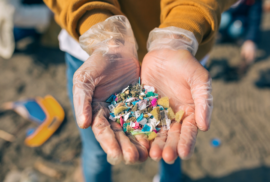Friends of the Rouge: Fighting floods with gardens & rain barrels

Authored by
When torrential rain hit Sandra Turner-Handy’s Detroit home in late June, her basement was immediately flooded.
She spent the next few days pumping out water, throwing out furniture, fixing a busted water heater and, worst of all, discarding the personal keepsakes of her late mother.
Then came two other “once-a-century” storms.
Southeast Michigan’s swathes of concrete and outdated sewer systems made it prone to flooding and sewer overflows, both of which were compounded by frequent, intense storms caused by climate change.
“Climate change is personal,” said Turner-Handy. “It stings you financially and pierces you emotionally, all while the everyday commitments of work and family continue.”
Unlike other buildings, the Plymouth Arts & Recreation Center (PARC) and its neighbors did not experience flooding this summer.
That is thanks, in part, to Friends of the Rouge. The nonprofit organization had just installed 20,000 square feet of rain gardens, which are designed to absorb water in amounts both massive and miniscule. It also renovated its three-acre parking lot so it would no longer become a manmade lake when rain fell.
When water hits the pavement now, it trickles into the rain gardens, leaving little water to make its way to streets, yards, creeks or basements.
Brenda Dittrich, of Grosse Pointe Farms, saw no flooding either. She’s long lived in old homes and taken care of their yards. All were prone to flooding when snow melted or rain splattered.
These past few years have been different, though. After learning how to make rain gardens through Friends of the Rouge, she created her own on the front and back yards of her property. She’s received no basement flooding or standing water since.
The stories of PARC and of Brenda are narratives within a big, bold mission of Friends of the Rouge. It is protecting its namesake Rouge River – which flows from Rochester Hills into the Detroit River – and the residents of the watershed – the heavily developed area around the river – from flooding.
Friends of the Rouge’s method? Install 1,000 rain gardens and 5,000 rain barrels in the watershed by 2025.
“It’s a really comprehensive solution that solves a lot of problems at the same time,” said Matthew Bertrand, restoration coordinator for Friends of the Rouge. “It’s also one of the cheapest.”

From asphalt lake to oasis
Bertrand remembers the old PARC parking lot well. Friends of the Rouge’s office is one of 47 arts, education and recreation organizations located there.
When it rained, the lot would turn into a lake, one that sometimes gushed over into neighboring yards and the street, picking up chemical pollutants as it went.
Then, much of that water would empty into storm drains leading to Tonquish Creek. The waters then merged with stormwater surges from other communities, to explode through the creek, flushing out wildlife, and threatening to overtop banks near homes downstream.
It was scenarios like this that made Tonquish one of the creeks most prone to flooding and to poor water quality in the Rouge River Watershed, which, in turn, was among the lowest-quality watersheds in the state.
PARC had already renovated its building – a former school – into a nonprofit hub educating and inspiring 150,000 people a year. It was time to do something similar with the parking lot, Bertrand said.
So, Friends of the Rouge partnered with PARC and applied for a grant from the Michigan Department of Environment, Great Lakes & Energy to create a world-class rain garden parking lot. They envisioned it protecting the Rouge River, its watershed and the people living in it. They also saw it as a place to educate people about rain gardens and the nature within them.
Their $400,000 grant was accepted in the summer of 2020, coupled with a multitude of individual and corporate donations.
Bertrand, a landscape designer, got to work. He partnered with an engineer to determine where the water pooled up and how it flowed. Then, they plotted out their rain gardens’ locations accordingly. Next came the parking lot, which they regraded, sometimes raising the lot up as much as two feet.
In the end, with the help of professionals and volunteers alike, a premiere rain garden parking lot was created. The lot is now capable of guiding rain and snowmelt to 23 gardens, which can absorb up to 240,000 gallons of water each rainfall.
The project was completed just before the series of “once-a-century” storms hit southeast Michigan. The rain gardens and parking lot did their work, absorbing all the water that would have otherwise collected chemicals and flooded the watershed and its communities.
“These rain gardens are a huge part of the solution,” said Bertrand. “Whereas this parking lot had been a gigantic problem, now we are soaking up an incredible amount of rain.”
Art as a bold goal
When the rain gardens are not absorbing water, they are inspiring, educating and protecting people, much like the nest of PARC nonprofits they surround.
Trees absorb carbon and provide shade. The gardens attract hummingbirds, bees, songbirds, Monarch butterflies and other creatures crucial to nature’s flourishing.
Bertrand said rain gardens change how you look at the world. It is why he and Friends of the Rouge are using the PARC rain garden to inspire others. He said he wants people to learn the value rain gardens have in protecting natural resources and communities. He wants others to be inspired by them and use Friends of the Rouge’s educational and volunteer resources to make their own or help make them for others.
It all fits snuggly into Friends of the Rouge’s 1,000-rain-garden, 5,000-rain-barrel goal.
Bertrand said this mission will not solve all the problems of the Rouge River Watershed. But rain gardens are a place to start. People can make one with a little guidance, time and spending, and everyone can see their impact on a personal, neighborhood and watershed level.
“We’re really building from that basic building block: each of our homes, where our families live and play,” said Bertrand. “If we start making our backyards better places to live, we can then build up to make our communities better places to live as well.”
Betrand said it is his job to show people how simple and affordable rain gardens can be.
He recognizes, though, that not all people have the ability to create rain gardens and some communities may need them more than others. Historic financial inequities, often stemming from bigotry, gave rise to more flooding, less shade to cool off in when heat waves hit and more air pollution in certain Metro Detroit communities.
That is where Friends of the Rouge will step in. It is placing those 5,000 rain barrels and 1,000 gardens not only in places where the watershed needs it most, but where people need it most, too.
With recent grant funding from the National Fish and Wildlife Foundation, the nonprofit is building rain gardens through Detroit at homes, churches and neighborhoods. It is also planting trees in Michigan’s most polluted zip codes, and it is working to expand investment into other communities experiencing disproportionate environmental burdens.
“Equal investment across the watershed is not gonna make an equitable outcome,” said Bertrand. “We need to really see significant investment in some of the communities that are hardest hit right now.”
Discover
Power environmental change today.
Your gift to the Michigan Environmental Council is a powerful investment in the air we breathe, our water and the places we love.
Sign up for environmental news & stories.
"*" indicates required fields




